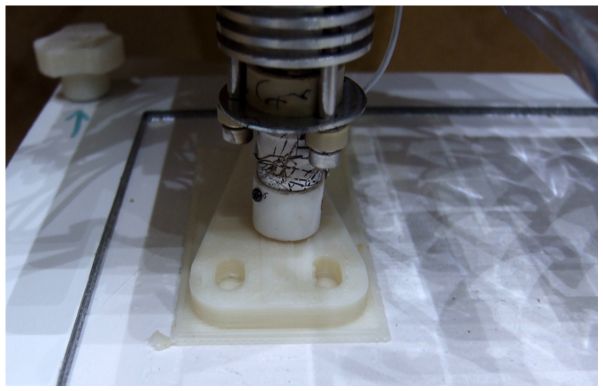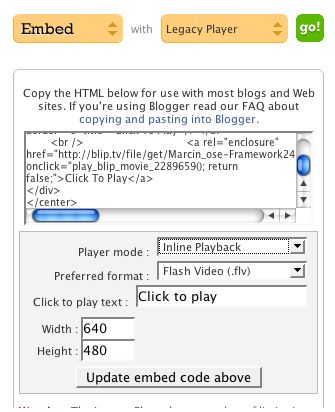Wiki instructions: Difference between revisions
No edit summary |
(→When to Delete: Clarification of "nonsense") |
||
| Line 110: | Line 110: | ||
A page is a good candidate for deletion if: | A page is a good candidate for deletion if: | ||
* it is '''clearly and beyond a doubt''' spam or complete nonsense | * it is '''clearly and beyond a doubt''' spam or complete nonsense (nonsense like "asd asdffasewsjh asdfl" and similar sequences of characters) | ||
* it's a redirect page whose title has nothing to do with the page it redirects to | * it's a redirect page whose title has nothing to do with the page it redirects to | ||
** As an example, we had a page titled '''My resume''' containing someone's resume. All pages pointing to ''My resume'' were updated to point to the user's resume, and all pages that pointed to it were updated to reflect the new title. | ** As an example, we had a page titled '''My resume''' containing someone's resume. All pages pointing to ''My resume'' were updated to point to the user's resume, and all pages that pointed to it were updated to reflect the new title. | ||
Revision as of 12:07, 12 January 2012
| OSE Required Reading | |||
|---|---|---|---|
| Wiki instructions · Crash course on OSE · Global Village Construction Set · Getting Started Guide · Team Culturing · Version control - Genealogies | |||
| Helpful Reading The Crash course on OSE page will help you understand the underlying intentions for the OSE Wiki so that your contributions can be as meaningful as possible. |
A wiki is a place where a large number of people can contribute to content generation and organization.
The critical point about a wiki is that it can be used as a repository for a large amount of information which can be organized later. We encourage you to internalize this point and start using wikis as a place where human knowledge can be collected, and value can be added to that knowledge by further organization towards applications.
Policies
In the ideal situation, a large messy hairball of input is organized into distilled, high-quality content. A successfully-implemented wiki has the capacity to self-organize under the guidance of clear procedures in the hands of wiki moderators; with this in mind, please make sure to familiarize yourself with these procedures as expressed in the following policies:
Content
There is a wide scope of things that can be included in the wiki - anything related to healthy, sustainable living, open source technology, good human relations, human empowerment, etc. OSE is about the integration of humans with technology in a benign way, with a focus on open source techniques. That's just about all under the sun that was historically proven to be worthwhile. Please be careful to keep this in mind while editing.
The wiki is designed to be a 'braindump' - please follow standards when adding new information per the Wiki Reorganization of 2011. Short entries, or stubs, are acceptable because they can be used as a definition later - even if nothing links at present. The expression braindump should not suggest a low level of quality; bad content to a Wiki is like bad nutrition to a body. If the Wiki is supposed to stay healthy, then a certain level of quality is essential.
Most of all, bad content, which is usually added by non-experts, discourages the distinctive experts from contributing. Everyone is urged to double-check his/her contributions, paying attention to respect, motivation towards others, accuracy and general quality. Both the motivation of positive contributors and the discouragement of negative contributors through content qualification is probably the strongest driver in wiki quality management.
The OSE Wiki-contents are different from typical wikis because the focus is narrowed to the support of OSE, with this difference in mind, a concentrated OSE Wiki can be built that serves its purpose.
"A Wiki is only as good as the search process is quick". It is a useful practice to examine the main wiki concerning any topics before starting an article.
Advertisement
There shall be no advertising on this wiki. Sourcing information and product reviews are allowed, as long as they are directly related to the creation of Distributive Economics.
Style Guidelines
- The first sentence of an article should be a one-sentence summary of the whole topic
- The next paragraph should be a longer summary of it
- Then go into details
- Be direct and practical
- Avoid acronyms, jargon and neologisms (or words like neologisms, which most people do not understand)
- Never use a long word or phrase where a short one will do.
- If it is possible to cut a word out, cut it out.
- Never use the passive where you can use the active (e.g. say "We built the house on Tuesday" rather than "The construction of the house took place on Tuesday".)
- Never use a foreign phrase, a scientific word, or a jargon word if you can think of an everyday English equivalent.
- Break any of these rules sooner than say anything outright barbarous.
- When writing about measurements, list both imperial and metric values. List both Fahrenheit and Celsius for temperatures.
Searching
You can search for content by typing your search terms on one of the search boxes at the top left corner
- The first search box will search for text matches on this wiki only
- The second search box will perform a custom Google search on this wiki, on our blog, on our discussion forum and other related sites, like Appropedia.
- For more details, see the page about the OSE custom search engine
| Search before creating a page Articles on our wiki should be cross-referenced against articles on neighboring wikis (like P2P Foundation or Appropedia) to avoid re-inventing the wheel any more than we have to. So, before creating a page, use the second search box to see if there are any existing articles on related wikis. If so, creating a link to it may be better than creating a new page, unless the existing page on the other wiki does not contain enough information. Articles from any wiki listed at Special: interwiki can be linked to by using the value at the Prefix column, like this: [[Appropedia: Comparison of electrical motors]]which creates this: Appropedia: Comparison of electrical motors |
Logging In
| Log in first! Before creating new pages or editing existing ones, you have to log in first. |
Any person contributing to the project in a substantial way should fill out the Team Culturing survey, and therefore, any name should be linkable with a full description of the person, such as Marcin Jakubowski. This will facilitate referencing and connection between projects and developers. The potential contributions of a person should be transparent if they fill out their abilities in the Team Culturing Survey.
Please see how to get a wiki account for more details or if you are unable to log in.
Grouping
- Categories can be used to organize a large number of pages, media, and even other categories. Read Using Categories for more information on proper categorization.
- subpages can also be used to group pages. They organize information hierarchically. However, too many nesting will lead to a long name that is hard to remember.
Creating New Pages
To start a new page or to edit an existing one, just type the desired page name in the search box at the top left corner (the one above the OSE custom search engine box) and click on the button labeled Go. If a similar page already exists, you might want to edit that page instead of creating a new one. Otherwise, click on the message Create the page "your page name" on this wiki! (at the top of the search results) to create the new page.
Then you can start editing the page. Also, while editing a page, you can create links to new or existing pages with double brackets around their title, for example:
[[My New Additions]]
Creating Subpages
| When to use subpages A subpage can be used to group pages belonging to some topic or main page
|
| User Spaces Pages on user spaces do not have to follow strict quality guidelines, as they are not official OSE content. Other pages should reflect more closely the official OSE stance on a given issue. |
If you want to create a subpage named A subpage name under a given page (for instance, My Parent Page), all you have to do is to create a page whose title is My Parent Page/A subpage name (see how to create a page).
You can also link to subpages from the parent page using a specific link format.
Examples
- User:Elifarley/pds - a subpage named pds in Elifarley's user space
Deleting Pages
When to Delete
A page is a good candidate for deletion if:
- it is clearly and beyond a doubt spam or complete nonsense (nonsense like "asd asdffasewsjh asdfl" and similar sequences of characters)
- it's a redirect page whose title has nothing to do with the page it redirects to
- As an example, we had a page titled My resume containing someone's resume. All pages pointing to My resume were updated to point to the user's resume, and all pages that pointed to it were updated to reflect the new title.
- Another example: a page named How to cook using only sunlight that redirects to Arduino controller schematics doesn't make sense. Either redirect it to a page that deals with the subject of cooking using only sunlight, or delete it.
How to Delete
Never delete a page that is not clearly and beyond and doubt a spam page. A redirect is often more appropriate.
You're urged to read Deleting a page and Sysop: deleting and undeleting before you delete a page.
Only Sysops can delete pages. If you're not a Sysop and you would like to mark a page as a candidate for deletion (see the criteria for deletion above), you should add the following text at the top of the page you would like to delete:
{{delete}}
This will include the delete template and will add that page to a list of candidates for speedy deletion.
And if a page is to be deleted, all pages pointing to it should be changed BEFORE the deletion occurs, to avoid broken links.
Redirecting
You can redirect a page to another page by replacing the contents of the original page with a #REDIRECT, like this:
#REDIRECT [[My destination article]]
You can redirect a page to an interwiki link too:
#REDIRECT [[Appropedia: Justa stove]]
Adding a category may help others find the page, since it'll be listed on the corresponding category page:
#REDIRECT [[Appropedia: Justa stove]] [[Category: Cooking]]
| Too many redirect pages? If you're afraid that the wiki will get cluttered with redirected pages, fear not. You can see this as a feature (a good one), not a bug, since anytime someone tries to add a page with title X (X being one of those redirected pages), they would be redirected to the appropriately-named page, instead of being given the chance to create a page with different title but similar content. |
Editing Pages
Tips
|
While in edit mode, there are some buttons at the top of the editing window to help with formatting text, creating links, inserting objects, etc.
Sections
Section headings are created by creating their headings, as below:
== First Section == === First sub-section === ==== First sub-sub-section ==== == Second Section ==
| Top-Level Sections Top-level sections should start with 2 equal signs at each side, as in ==My Top-Level Section Example== Sections with only one equals sign per side causes a title the size of the page name. On Wikimedia wikis they are used only sparingly and in prescribed circumstances. |
Inserting Tables
You can copy and paste your data from your spreadsheet to http://area23.brightbyte.de/csv2wp.php and it will convert it to a cut and pasteable mediawiki table.
Inserting Templates
You can insert a template using this code:
{{My Template}}
To create or edit a template named My Template, simply create a page named Template: My Template (see how to create a page).
Text Markup
Text color
Put in the name of the color in this markup:
<span style="color: green">Some text</span>
The example above generates this:
Some text
Strikethrough
Strikethrough
Inserting Images
Uploaded Images
To insert an image, anywhere in the body of a page, type:
[[Image:filename.jpg]]
Then click Save page. After the page is saved, you'll be allowed to click on that filename, and the wiki will prompt you for an image file to upload.
External Images
You can simply paste links to images from any of the sites defined on MediaWiki: External image whitelist. See also: $wgEnableImageWhitelist
Example: http://openfarmtech.org/temp-gvcs-icons/3d-printer.png gives this image:
http://openfarmtech.org/temp-gvcs-icons/3d-printer.png
Inserting Image Galleries
Use the gallery tag. Example code:
<gallery> Image:fefrepstrap1.jpg Image:fefrepstrap2.jpg Image:fefrepstrap3.jpg Image:fefrepstrap4.jpg Image:fefrepstrap5.jpg </gallery>
Produces this:
Directly Linking to Uploaded Files
You can create links to any kind of uploaded file (be it an image, a PDF file, etc).
Please see instructions at the top of the Special: Upload page.
(See also #Editing Pages)
Inserting Movies
Youtube Videos
To insert clickable thumbnails of YouTube videos, use Template: YoutubePopup, as in this example:
- YouTube video you want to embed: http://www.youtube.com/watch?v=6dwdAF2qr7g&feature=player_embedded
- Wiki syntax you should use: {{YoutubePopup|6dwdAF2qr7g}}
which produces
http://img.youtube.com/vi/6dwdAF2qr7g/default.jpg
Other Videos
To insert videos in general, see this example:
<html> <object width="526" height="374"><param name="movie" value="http://video.ted.com/assets/player/swf/EmbedPlayer.swf"></param><param name="allowFullScreen" value="true" /><param name="allowScriptAccess" value="always"/><param name="wmode" value="transparent"></param><param name="bgColor" value="#ffffff"></param><param name="flashvars" value="vu=http://video.ted.com/talk/stream/2011U/Blank/MarcinJakubowski_2011U-320k.mp4&su=http://images.ted.com/images/ted/tedindex/embed-posters/MarcinJakubowski-2011U.embed_thumbnail.jpg&vw=512&vh=288&ap=0&ti=1122&lang=eng&introDuration=15330&adDuration=4000&postAdDuration=830&adKeys=talk=marcin_jakubowski;year=2011;theme=design_like_you_give_a_damn;theme=new_on_ted_com;theme=the_rise_of_collaboration;theme=tales_of_invention;theme=talks_from_ted_fellows;event=TED2011;tag=Culture;tag=Technology;tag=open-source;tag=ted+fellows;&preAdTag=tconf.ted/embed;tile=1;sz=512x288;" /><embed src="http://video.ted.com/assets/player/swf/EmbedPlayer.swf" pluginspace="http://www.macromedia.com/go/getflashplayer" type="application/x-shockwave-flash" wmode="transparent" bgColor="#ffffff" width="526" height="374" allowFullScreen="true" allowScriptAccess="always" flashvars="vu=http://video.ted.com/talk/stream/2011U/Blank/MarcinJakubowski_2011U-320k.mp4&su=http://images.ted.com/images/ted/tedindex/embed-posters/MarcinJakubowski-2011U.embed_thumbnail.jpg&vw=512&vh=288&ap=0&ti=1122&lang=eng&introDuration=15330&adDuration=4000&postAdDuration=830&adKeys=talk=marcin_jakubowski;year=2011;theme=design_like_you_give_a_damn;theme=new_on_ted_com;theme=the_rise_of_collaboration;theme=tales_of_invention;theme=talks_from_ted_fellows;event=TED2011;tag=Culture;tag=Technology;tag=open-source;tag=ted+fellows;&preAdTag=tconf.ted/embed;tile=1;sz=512x288;"></embed></object> </html>
The code above generates this:
For any video, insert the <html> and </html> tags, and put in the html code that you get from YouTube or some other video format.
Embedding from Blip.tv
Here is a sample embed settings screen from blip.tv. Note that you do 'share', 'legacy player', then click 'go.' Then, make sure you select 'in-line player', flv for flash video - and then click 'update embed code above'. Then, copy the code into the blog, and in the blog, make sure you are in HTML, not visual, mode.
Subtitling Videos
Here's how to activate Universal Subtitles for your videos:
1- Go to http://universalsubtitles.org/ and click on "Subtitle a video" 2- Paste the URL of the video you want to have subtitled. The URL can point to a file in Ogg, WebM or FLV format, or it can point to a video hosted on YouTube or Blip.TV (Vimeo support will be available soon). Examples of URL:
WebM file: http://content.bitsontherun.com/videos/m3P14laP-283112.webm YouTube video: http://www.youtube.com/watch?v=shqrdCBTD70 Blip.TV video: http://blip.tv/file/3841170/
3- A black page with a central video and a close button (a red tab on the top right corner) will appear. This is the initial step where users can start typing the subtitles for the video. Since you probably don't want to create the subtitle text right away, but instead want the embed code to paste on your blog, you can just click on the close button.
4- In the next screen, the embed code can be found inside the text box below "Embed this video in your site". Just click on the 'Copy to clipboard' icon next to it. The embed code will look like this:
<script type="text/javascript" src="http://s3.www.universalsubtitles.org/embed.js">
(
{"video_url": "http://www.youtube.com/watch?v=shqrdCBTD70"}
)
</script>
This embed widget is in alpha stage, so it may have some bugs. I have tested it with youtube videos and it worked quite well. With Blip.TV, the video wouldn't play though.
It'll be really great when it's working correctly with Vimeo and Blip.TV
Inserting Mathematical Symbols
You can write LaTeX code to render math symbols on our wiki, which uses MathJax to display them.
Example:
<math>
\operatorname{erfc}(x) =
\frac{2}{\sqrt{\pi}} \int_x^{\infty} e^{-t^2}\,dt =
\frac{e^{-x^2}}{x\sqrt{\pi}}\sum_{n=0}^\infty (-1)^n \frac{(2n)!}{n!(2x)^{2n}} + \sfrac{(2a)!}{n!(2b)^{2n}}
</math>
produces this:
<math>
\operatorname{erfc}(x) =
\frac{2}{\sqrt{\pi}} \int_x^{\infty} e^{-t^2}\,dt =
\frac{e^{-x^2}}{x\sqrt{\pi}}\sum_{n=0}^\infty (-1)^n \frac{(2n)!}{n!(2x)^{2n}} + \sfrac{(2a)!}{n!(2b)^{2n}}
</math>
while this
this is \( \sfrac{1}{4} \) of a minute...
produces this:
this is \( \sfrac{1}{4} \) of a minute...
Inserting Source Code
Always wrap source code in 'pre' tags. This ensures proper formatting, and means that someone can copy code without having to 'edit' the page first.
An example looks like this (you can view the markup in Edit mode):
int mainup = 5; // Define pins by plugin of hydraulics int maindown = 6; int secin = 10; int secout = 11; // Define pins 5, 6, 10, and 11 according to their hydraulic // function on the CEB press - moving main cylinder up and down, // and moving secondary cylinder in and out. 'In' is defined as // the direction of brick ejection motion out of the machine.
Adding Categories
If you want to add a specific category to your page, please check the already existing list of categories.
Cheatsheet
You can see visually our Cheatsheet of the Wiki code.
Next steps
This wiki is powered by MediaWiki. For complete and up-to-date technical information about using this wiki, refer to the MediaWiki help pages. Keep this page in mind as a reference for future use.
If you're confident about your understanding of everything written in this page, the following pages will point you towards what to do next:






